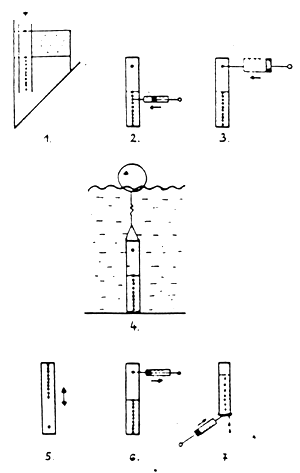The total nitrogen fixation of a 20 cm long sediment core is measured for determining the nitrogen fixation of the lake sediment. Enzyme-saturation with acetylene and incubation are performed in situ in the undisturbed sediment layers, and the ethylene produced is liberated into the gas phase by vigorous shaking of the sediment core after incubation.
Hargrave sampler
sampling and reaction tube, approximately 40 cm long with 4.5–5 cm inner diameter
polyethylene tube with holes one in the middle of the upper half and 10 others (at 2 cm intervals) in the lower part of the tube fitted with silicon rubber
rubber stoppers for the upper and lower ends of the polyethylene tube
balloon for gas storing (as before)
syringes 1 and 50 cm3, respectively, with well fitting piston
Perlon string
jar for gas storage (as before)
gas chromatograph (description as above)
bi-distilled water
ion-free water saturated with acetylene gas (1.6 cm3 C2H2 can be saturated in 1 cm3 water)
ethylene gas
mercuric chloride solution (saturated)
The sediment sample is taken with the Hargrave sampler. Driving half of the tube into the sediment, a 20 cm-long sediment core is collected in such a way that the upper layer of the sediment is in line with the uppermost hole in the middle of the tube. The bottom end is then closed with a rubber stopper. After siphoning the water above the sediment, the top should also be stopped. With a syringe, 0.5 cm3 acetylene-saturated, ion-free water is injected into the sediment through holes closed with silicon-rubber stoppers. For the complete penetration and distribution to saturate enzyme sites, this amount is given in portions at five different angles of the needle. By this treatment, 3–4% acetylene concentration in the interstitial water is achieved. Then 50 cm3 air is withdrawn from the space above the sediment and replaced by the same amount of acetylene gas. Thus the space contains about 15% v/v acetylene. The sediment tube thus treated is incubated in situ for 4 hours (t-incubation), suspended on Perlon string and lowered to the bottom in a vertical position. The incubation is followed by vigorous shaking (30 sec) of the tube so as to release the ethylene produced in the sediment. Then 20 cm3 is withdrawn from the gas phase (v gas phase) with a syringe and directly injected into a gas storing jar filled with ion-free water and kept in reversed position. The sample then can be transferred to the laboratory (Fig. 2).
The procedure which follows, including calibration, is the same as that described for water. The peaks of ethylene and acetylene respectively are registered, their heights measured (H sample, ethylene; H-sample acetylene) and F (nmol.mm-1), calibration coefficient calculated.
The control is treated the same way, with the exception that before injecting the acetylene saturated water, 2 cm3 HgCl2 solution is injected into each layer of the sediment core evenly distributed at five different angles of the needle. Peaks corresponding to ethylene and acetylene are registered, their heights measured (Hcontrol, ethylene; Hcontrol, acetylene).
The concentration of ethylene in the gas sample produced during the biological acetylene reduction is calculated with the following equation:
Csample, ethylene (nmol cm3) =

Rate of acetylene reduction (u) as related to a unit volume of sediment:

while the rate of nitrogen fixation (w) was related to a unit volume of sediment is:
w (nmol N2 cm-3 h-1) = k u

Surface rate (φ), characteristic of nitrogen fixation as related to a unit region of sediment surface is:
φ (nmol N2 cm-2 h-1) = w h,
where h is the length of the sediment core.

Fig. 2 Measurement of N-fixation in the sediment
Sediment from Hargrave sampler
Injecting acetylene saturated water
(0.5 cm3)
Injecting acetylene gas (50 cm3)
In situ incubation (4 h)
Shaking (30 sec)
Gas sampling (20 cm3)
Storing of gas sample
Nitrogen fixation in the lake sediment (M) for longer periods and extended water region can be calculated by summing the nitrogen fixation value characterizing the different times and spaces (φik)

| where: | tik | = | duration of different periods of time |
| n | = | number of periods of time | |
| Fik | = | area of different regions | |
| m | = | number of different regions | |
| K | = | constants depending on the units of measurements chosen |